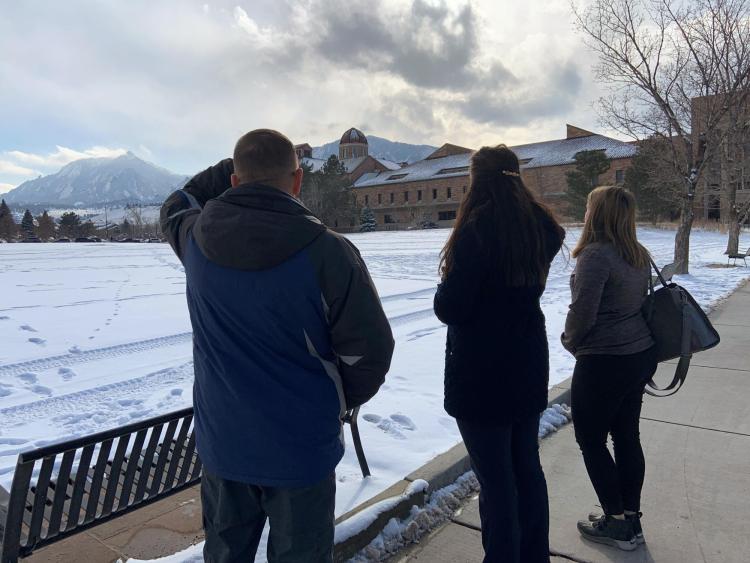CUPD earns grant; Campus embarks on security audit, upgrades
The University of Colorado Boulder Police Department (CUPD), in collaboration with Facilities Management, will use $3.4 million in state-controlled maintenance funding to improve classroom security in the event of a future active harmer or other mass-casualty incident.
As part of this project, CUPD was also granted funding for technical assistance from the Collaborative Reform Initiative Technical Assistance Center (CRI-TAC), a program of the U.S. Department of Justice. Through consultation, the assistance will not only offer guidance in security measures and protocols based on construction plans, it may also influence educational programming aimed at students, faculty and staff, including how campus handles messaging during emergencies.

CUPD and CRI-TAC officials take a walking tour of campus as part of a security audit, March 10, 2022. Photo courtesy of CUPD.
The improvements will support the university’s “Run, Hide, Fight” active harmer response protocol, ensuring campus community members can take those action steps no matter their physical abilities or which classroom they’re in.
“It’s important to understand this project is about much more than just locks on classroom doors,” said CU Boulder Assistant Vice Chancellor for Public Safety and Chief of Police Doreen Jokerst. “Locks can help people hide, but not every member of our campus community can run or fight. We want to look at safety from a holistic perspective.”
Jokerst noted, since there is no widely accepted playbook for security in higher education, CU Boulder has a tremendous opportunity to research and write its own. And while the goal is to make CU Boulder the safest campus in the nation, CUPD plans to share final recommendations with other universities nationwide.
CUPD is currently engaged in phase one of the multi-part project, which includes a campus security assessment and comprehensive review of active harmer events at higher education institutions from 2000 to 2021. That work will lead to an action plan to increase CU Boulder’s campus security that could serve as a national model for other universities, regardless of size or student population.
CUPD is working with CRI-TAC consultant Robert Mueck, who visited campus earlier this month, conducting a walking tour of CU Boulder’s infrastructure with CUPD emergency management officials. The retired police chief and threat assessment expert also met with other local first responders to review campus building and classroom safety practices and procedures.
CUPD also will work with an architect and contractor on the feasibility, cost and implementation of recommendations. “This is much more than looking at tactical response—this is risk mitigation through environmental design,” Mueck said. “Students, faculty and staff may not even notice the physical differences that are made, but it’s a back-end way to possibly save lives.”
Brian Lindoerfer, assistant vice chancellor for facilities operations and services, said teamwork made it possible to launch the project at an opportune time. “Receiving the full amount of our request was essential to being able to take this holistic approach to improving our campus physical security measures. It was a collaborative effort between Infrastructure & Sustainability, CUPD and the Office of the State Architect to justify this critical need for resources and help us accelerate the timeline for these multi-phase improvements.”
Construction on recommended security updates would take place during the summer months on CU Boulder’s Main and East campuses.


